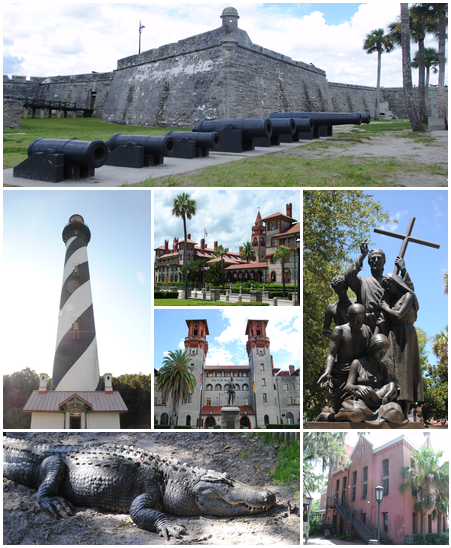
Moving to St. Augustine, Florida: A Comprehensive Relocation Guide
Considering moving to St. Augustine, Florida? This historic St. Johns County city offers America’s oldest city charm, Atlantic beaches, and cultural richness. With approximately 15,000 residents in 2025 (metro 95,000+), St. Augustine combines colonial heritage with coastal living and Northeast Florida’s premier tourist destination.
Demographic Profile to Consider If Moving to St. Augustine:
St. Augustine’s 2025 city population is approximately 15,000 residents, with the broader area exceeding 95,000. The median age is around 44 years, with diverse residents including tourists workers, professionals, retirees, and families. The population is approximately 72% White, 16% Hispanic, 8% Black or African American. St. Augustine features the beautifully preserved historic downtown with colonial Spanish architecture, beachside communities on Anastasia Island, and suburban developments throughout St. Johns County. Founded in 1565, St. Augustine is America’s oldest continuously occupied European settlement, with this heritage defining its identity. The city attracts history enthusiasts, tourism professionals, and those seeking authentic character with beach access. The community balances historic preservation with tourism economy and residential growth. Find trusted local services for moving, living, and working in St Augustine.St Augustine Relocation Directory
Cost of Living to Consider If Moving to St. Augustine:
St. Augustine offers moderate to upper-moderate costs for Atlantic Coast living. Median home values range from $380,000 to $520,000 in 2025, with historic downtown and beachfront properties commanding significant premiums. The median household income is approximately $60,000. Rental properties average $1,800 to $2,600 monthly. Florida’s absence of state income tax benefits residents. Overall cost of living reflects the area’s tourism appeal, historic character, and beach access. St. Augustine attracts diverse income levels from service workers to affluent historic home owners. Housing costs vary dramatically from modest areas to luxury historic properties and oceanfront estates. The combination of history, beaches, and character justifies moderate to premium pricing.
Economy and Job Market:
St. Augustine’s economy revolves around tourism, hospitality, education, and healthcare. The city welcomes millions of annual visitors to historic sites, beaches, and attractions. Major employers include Flagler Hospital, St. Johns County Schools, Flagler College, and extensive hospitality sector including hotels, restaurants, and tour operators. The historic downtown’s shops and attractions create significant service employment. Real estate and construction serve growing St. Johns County. Many residents work in tourism, healthcare, education, and professional services. The seasonal tourism creates employment fluctuations. Some commute to Jacksonville for professional employment. Typical industries include hospitality, healthcare, education, and historic preservation.
Education:
St. Johns County School District serves St. Augustine students with highly-rated schools throughout the area. The district consistently ranks among Florida’s best. Flagler College occupies historic buildings downtown offering four-year liberal arts programs in unique setting. St. Johns River State College provides associate degrees. The University of North Florida in Jacksonville is accessible. The educational infrastructure serves the community well, with St. Johns County schools attracting families specifically for educational quality.
Recreation and Lifestyle:
St. Augustine offers unparalleled historic attractions including the Castillo de San Marcos National Monument, historic downtown with colonial architecture, St. Augustine Lighthouse & Maritime Museum, and Fountain of Youth Archaeological Park. The city features beautiful Atlantic Ocean beaches on Anastasia Island including St. Augustine Beach. Residents enjoy walking the historic streets, touring museums, dining at waterfront restaurants, and beach activities. The city hosts numerous festivals celebrating heritage. The St. Augustine Amphitheatre presents concerts. Golf courses serve residents. The lifestyle combines historic tourism with coastal living and cultural events. The subtropical climate enables year-round historic touring and beach enjoyment. The community values historic preservation, tourism, and authentic character. Living in America’s oldest city means embracing tourism while finding residential identity.
Healthcare and Services:
St. Augustine residents access comprehensive healthcare through Flagler Hospital providing full-service care. Additional facilities throughout St. Johns County offer medical services. Jacksonville’s major hospitals provide specialized care when needed. The region’s healthcare infrastructure serves both permanent residents and tourists adequately.
Transportation:
St. Augustine is accessed via Interstate 95, U.S. Highway 1, and State Road A1A along the coast. Jacksonville International Airport is approximately 50 minutes north. Sunshine Bus Company operates transit service. Historic downtown offers walkability. Most residents use personal vehicles. Typical commute times to Jacksonville range 45-60 minutes. Traffic congestion occurs in historic areas during tourist season.
Conclusion:
Moving to St. Augustine in 2025 offers historic city living with colonial charm, Atlantic beaches, and cultural richness. The city’s combination of 450+ years of history, beautiful coastline, preserved architecture, and tourist energy makes it ideal for history lovers, cultural enthusiasts, and those seeking America’s most historic community where every street tells centuries of stories and coastal beauty complements colonial heritage.

